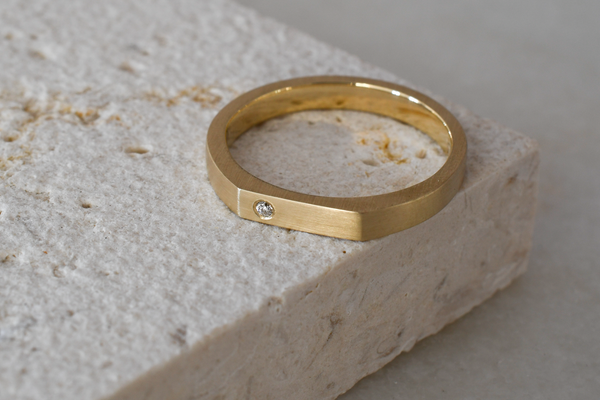Lab grown diamonds have taken the jewellery industry by storm in the last couple of years. This popularity may lead you to think they are a relatively recent invention but in actuality the first lab grown diamond was grown in 1954. Their growing acclaim is due, in no small part, to the growing awareness of the human and environmental abuses so prevalent in the mined diamond trade.
But what about these claims? Are lab grown diamonds actually the more ethical choice?

A comparison: The environmental impact of mined vs lab-grown diamonds
The process of mining a single diamond carat emits 64 kilograms of CO2. Lab grown diamonds aren’t exactly carbon neutral either, a huge amount of energy is needed to generate the heat and pressure required by the process. Exact figures can be hard to come by though and, just like mined diamonds, not all lab-grown diamonds have the same environmental impact.
A report from 2014 by the consulting firm Frost and Sullivans calculated that mined diamonds require twice as much energy per carat as those grown in a lab. The next important factor in the equation is the source of that energy. This ranges from dirty diesel-based fuel (common in mining operations) to more controlled, cleaner fuel sources such as national energy grids, to completely renewable energy sources like wind and solar. Clean energy is carbon minimal energy. What we should really be asking is not how much energy but what kind of energy?
Another report however, notably commissioned by seven of the world’s largest diamond mining companies, suggests that greenhouse emissions from lab grown diamonds are three times higher than their mined counterparts. Experts however are pushing back on this report’s conclusion, “To claim that their carbon and energy footprint is less than synthetic... defies common sense.” Says Saleem Ali, professor of energy and the environment at the University of Delaware. The creation of a diamond in a lab is relatively straightforward requiring just carbon and energy, whereas mining is much more complex involving extensive exploration, heavy machinery, transportation, and explosives
What is clear is that there is no clarity. The emissions data is inconsistent and easily swayed based on the agenda at play. Mined or lab grown, where you source your diamond matters much more than generic figures applied to an industry with factors as variable as a length of string.

That being said, the environmental impact of diamond mining goes far beyond just its carbon emissions. Acid mine drainage pollutes water ways and drinking water sources, an impact described by Canada’s University of Waterloo as “one of the mining industry’s top environmental liabilities”.
Then there is habitat destruction. Traditional diamond mining displaces 250 tons of earth for every carat mined. From the remaining tiger population in India to the destruction of the sea beds off the Namibian coast, diamond mining is pushing critically endangered species and delicate ecosystems closer to the edge.
These environmental factors are where lab grown diamonds come out top. A mined diamond consumes more than 180 litres of water per carat. Lab-grown diamonds, on the other hand, consume just 68. And, because no earth is displaced for the production of lab grown diamonds (other than a modest factory setup in already developed areas), wild spaces and sacred lands are left untouched.
The social implications of lab-grown and mined diamonds
Lab-grown diamonds are created in highly specialised laboratories. This necessitates high start-up costs and very specialized skills. It is a technology only available to fairly big companies in developed economies. Which, whilst it excludes many people from accessing the market, also means that lab-grown diamonds are not plagued by any of the human rights abuses and atrocities that plague the mined diamond industry.
Blood diamonds, mined diamonds whose sale is used to fund wars and terrorist organizations, are perhaps the most infamous of diamonds. In 2003 the Kimberly Process Certification Scheme was introduced to try and stop these diamonds entering the mainstream market. A noble goal, albeit with a rather limited scope as it does not tackle the myriad of other human rights abuses associated with mining.
Unfortunately, the cracks are starting to show in the Kimberly process. There have been multiple reports of conflict diamonds circulating freely in the market even with the overview scheme in place. A mined diamond changes hands up to thirty times before reaching the consumer making the opportunity for deception depressingly easy. A mined diamond’s traceability is perhaps the most fraught of any of the precious stones.
 Image Credit: Dapo Abideen
Image Credit: Dapo Abideen
When buying a lab-grown diamond you can rest easy that no human rights atrocities such as child or forced labour have been involved in its creation but vigilance is still needed to ensure that ethical labour practices have been involved in the entirety of its life cycle. Traceability remains key as cutting facilities (used for both mined and lab-grown diamonds) are often plagued with their own social issues.
It is clear that the mined diamonds industry is riddled with issues but on the other side of that same coin are the millions of people worldwide who depend on diamond mining. It’s not an easy living, many miners earn low wages (some as little a dollar a day) in unsafe conditions, but it is the only viable income available to many communities.
Diamond mining can be better, in fact many people are trying to make it better. But the reality is until there is an independent fair-trade certification for diamonds, as there is for coffee and gold, a cloud of uncertainty will hang over almost all mined diamond purchases.
AuTerra’s diamond choices

Fundamentally, all mining – whether it’s for gold, silver or diamonds – is a brutal business. Mines churn up vast tracts of land, pollute waterways and devastate wildlife. And because so much mining takes place in the developing world, the stakes for the income it generates are high, and the battle for resources often violent.
We searched high and low for a lab-grown diamond company that shared our vision for a more sustainable, transparent and ethical future for the jewellery industry and our planet at large. All our diamonds are grown in a lab in Mauritius and cut and polished either in Mauritius or locally here in South Africa, both countries with rigorous labour laws. Whilst the lab currently uses a mix of the conventional power grid and solar power, they are working towards becoming completely carbon neutral, a goal we share.
The topic is definitely a complex one, but the choice of carefully sourced lab-grown diamonds feels right for us and the kind of mark we want to leave on the world, one with a little bit of sparkle.

